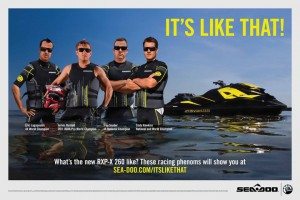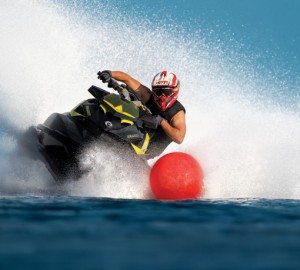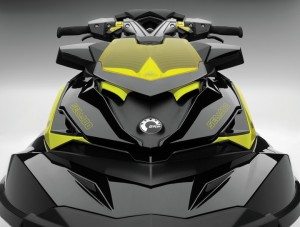Sea-Doo touts new RXP-X with video
Social media allows viewers to see ‘It’s Like That’
Of all the PWC brands, Sea-Doo taps most heavily into the realm of social media. A new marketing campaign — dubbed “It’s Like That” — attempts to leverage the online video concept even further with unique, offbeat imagery to convey the highlights of the new Sea-Doo RXP-X 260.
Will this message — and other video attempts like them — reach the consumer, and perhaps more importantly, send them into dealerships?
‘Remarkable Visuals’
The “It’s Like That” videos are part of a multi-pronged strategy behind the launch of the new RXP-X 260. The campaign began with more in-depth feature videos with lead designers, continued with Sea-Doo’s nationwide demo tour and World Finals, and now focuses on more innovative, quirky videos to drive the message home.
“The RXP-X 260 has some very innovative design elements that truly make it unique,” said Tim McKercher of LOOK Marketing (formerly WaterTop Unlimited), the Sea-Doo brand communications and event-marketing agency that produced the videos. “The way the rider rides it, the way it looks and the way it handles are really hard to get across in words, or even regular action footage. A test ride is the best way to experience it, but not everybody has a chance, so we had to figure out how to get the major innovations across in a meaningful manner.”

Drawing inspiration from other campaigns that used “remarkable visuals” — think Reebok’s “Pick Me” fantasy football videos or Kia’s hamster “This or That” spots — LOOK focused on analogies to drive home a point.
“The ErgoLock system, T3 hull handling and addition of iControl had analogies flying all over the place explaining what the new RXP-X was ‘like,’” McKercher said. “So we took some very straightforward, non-PWC-related analogies and connected them to the product.”

Those analogies featured current Sea-Doo X-TEAM members and simple, relatable concepts. Eric Lagopoulos, a successful restaurant owner, is shown in the kitchen, heating a knife with a blowtorch, and then slicing it through butter. Troy Snyder is shown assembling LEGOs with his child, focusing on the locking together concept of the toy. James Bushell is seen racing toy slot cars. Cody Hawkins compares a vintage car without wheels to a Porsche burning rubber. Peter Fleck culminated the series in stop-and-go traffic, noting his frustration was “not like that” feeling of Sea-Doo’s braking system.
The video collection was timed to go public via Sea-Doo’s OnBoard blog, found at www.sea-doo.com/onboard, and create exclusive content that would drive traffic to the company’s website.

“The timing was to allow people taking time off during the holidays and surfing the web to see a new video every other day leading up to Christmas and the beginning of boat show season,” McKercher said. “Facebook, Twitter, Goggle+ and the Sea-Doo e-newsletter all drove consumers to the videos that now reside on the RXP-X page on Sea-Doo.com.”
New Media, New Message
While J&M Camper & Marine owner Jeff Stoddard admits it’s difficult to know social media’s impact on a product, he believes this type of video focus has helped spread Sea-Doo’s brand message, especially when it comes to detailing new features.
“I’ve had consumers that came in looking for the Sea-Doo with the brake because they saw it on YouTube,” said Stoddard, whose dealership in Augusta, Maine, has embedded some of the feature videos into its website. “It’s helped us and our ability to market the product without having to type an entire page on a feature. It’s like the old saying, ‘If a picture is worth a thousand words, what’s a video worth?’”
Dave Bamdas, owner of RIVA Motorsports, a dealership with locations in Pompano Beach, Miami and Key Largo, Fla., sees social media and online videos as just about the last bastion for product promotion.
“Social media and online videos are definitely where things have to go,” Bamdas said. “Print media in the personal watercraft industry is essentially gone. At this point either the customer goes to the manufacturer’s website to seek out that information, they go to a dealer’s website, or they are somehow exposed to this less conventional advertising.”
As getting a video to go viral is essentially a marketing home run, the less conventional, the better.
“If it was just ‘BRP presents the new RXP-X 260’ it wouldn’t get passed around as a viral video. You can expect it to get shared by more people if it has a little bit of coolness factor, if it’s a little bit offbeat,” Bamdas said.
These campaigns are also typically far less costly to produce than conventional print or TV advertising. As Bamdas notes, that’s the beauty of it.
“You can totally shotgun it. If even one catches on, it could go huge. How else are we going to get to these people? Print ads are gone. They may come to an event like a boat show. This is a way we can reach them on their computer or on their cell phone or anywhere.
“It really comes down to how creative can you be. Production costs are low, and you’ve got an unlimited amount of chances online.”








